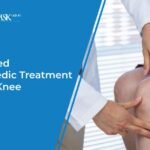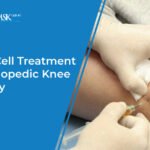You might need a knee examination if you have severe knee pain or impairment. To address this issue, orthopedics offers a variety of treatments, such as injections of hyaluronic acid and corticosteroids, various medicines, and physical therapy. activities that build muscle and targeted activities can also increase flexibility. It is imperative that you speak with a medical expert to find out if a knee replacement surgery or other therapies are right for you. Dr. Shohab Hyder Shaikh is a renowned orthopedic surgeon in Karachi, specializing in hip and knee surgeries in Karachi. Here are some of the different ways an orthopedic surgeon can take care of your knee pain. Check out the blog for a detailed explanation to gain a better understanding of it.
When and Why Knee Treatment Is Necessary
When conservative therapy proves inadequate in managing substantial knee pain and dysfunction, total knee replacement surgery becomes an option. Osteoarthritis is frequently the primary indicator, characterized by joint cartilage degradation that results in pain, edema, and reduced mobility. Knee replacement surgery may be required due to inflammatory arthritis, post-traumatic arthritis from traumas, unsuccessful previous operations, uncommon illnesses such bone tumors or osteonecrosis, and significant deformities in the knee.
The Most Recent Advances in Orthopedic Knee Treatment Techniques
To gain a deeper understanding of knee replacement surgery, we have covered five distinct approaches in this blog post thus far.
- Injections of Corticosteroids
One common treatment for osteoarthritis in the knee is an intra-articular steroid injection. According to clinical study, the benefit is only transient, lasting between one and four weeks. Controlled investigations and clinical experience have shown that the short-term effects of steroids vary; some patients treated by rheumatologists experience a robust and prolonged response that lasts for more than a few weeks.
- Injection of Hyaluronic Acid
Viscosupplementation, often known as hyaluronic acid injections, involves injecting a gel-like substance into the knee joint to enhance lubrication and stress absorption. This treatment reduces friction and enhances joint function to provide long-term comfort. It is particularly beneficial for people with osteoarthritis. Hyaluronic acid injections decrease the body’s natural synovial fluid, which eases pain and improves range of motion. When compared to corticosteroids, the effects last for multiple months.
This treatment offers comfort that lasts longer, which makes it a great option for anyone looking to control their knee osteoarthritis symptoms over the long term.
- Replacement Therapy with Platelet Rich Plasma
A patient’s blood is extracted, concentrated platelets are added, and the patient is then given an injection into the knee as part of a regenerative procedure known as platelet-rich plasma (PRP) therapy. Growth factors included in these platelets promote tissue regeneration and cellular repair. In addition to promoting healing and reducing inflammation, platelet growth factors may also slow the onset of diseases like osteoarthritis.
- Drugs
Orthopedic doctors treat knee replacement surgery with a variety of medications that have the ability to relieve it.
Aspirin
COX enzymes are inhibited by aspirin, a nonsteroidal anti-inflammatory drug (NSAID). By inhibiting these enzymes, aspirin reduces the production of prostaglandins, which result in fever and inflammation. Aspirin can help reduce inflammation and pain brought on by conditions like osteoarthritis in the knee.
Ibuprofen
Similar to this, the NSAID drug ibuprofen suppresses the generation of prostaglandins by inhibiting COX enzymes. As a result of this mechanism, knee pain and inflammation are reduced. Ibuprofen, which is often used to treat ailments like osteoarthritis, relieves knee pain by targeting the underlying inflammatory processes that cause it.
- Physical Medicine
Promoting knee health requires physical therapy, particularly for conditions like osteoarthritis and post-surgical rehabilitation.
The first and most crucial element is strengthening your muscles. Exercises designed specifically to strengthen the muscles surrounding the knee provide the required stability and support. Increasing adaptability is another crucial factor. Specialist exercises are employed by physical therapists to enhance knee joint flexibility.
Osteoarthritis symptoms can also be controlled with the aid of physical therapy. In order to manage pain, minimize inflammation, and preserve joint mobility, therapists employ targeted exercises. Hand manipulation and hot/cold treatment are two methods that can be utilized to effectively control symptoms.
Physical therapists provide essential knowledge on safe joint usage, proper body mechanics, and at-home exercise regimens. Patients are given the information necessary to play an active role in their rehabilitation and proactive measures to maintain long-term knee health as a result of this education.
Conclusion
Pain in the knee joint can be caused by various conditions, such as osteoarthritis, knee arthritis, ligament damage, or injuries to the knee replacement surgery. Orthopedic doctors handle these problems in different ways. These consist of injection-based therapies, medication, including NSAIDs, physical therapy, and activities that strengthen muscles. By putting such a treatment into practice, pain, irritation, and inflammation around the knee joint and related limb can be reduced.








